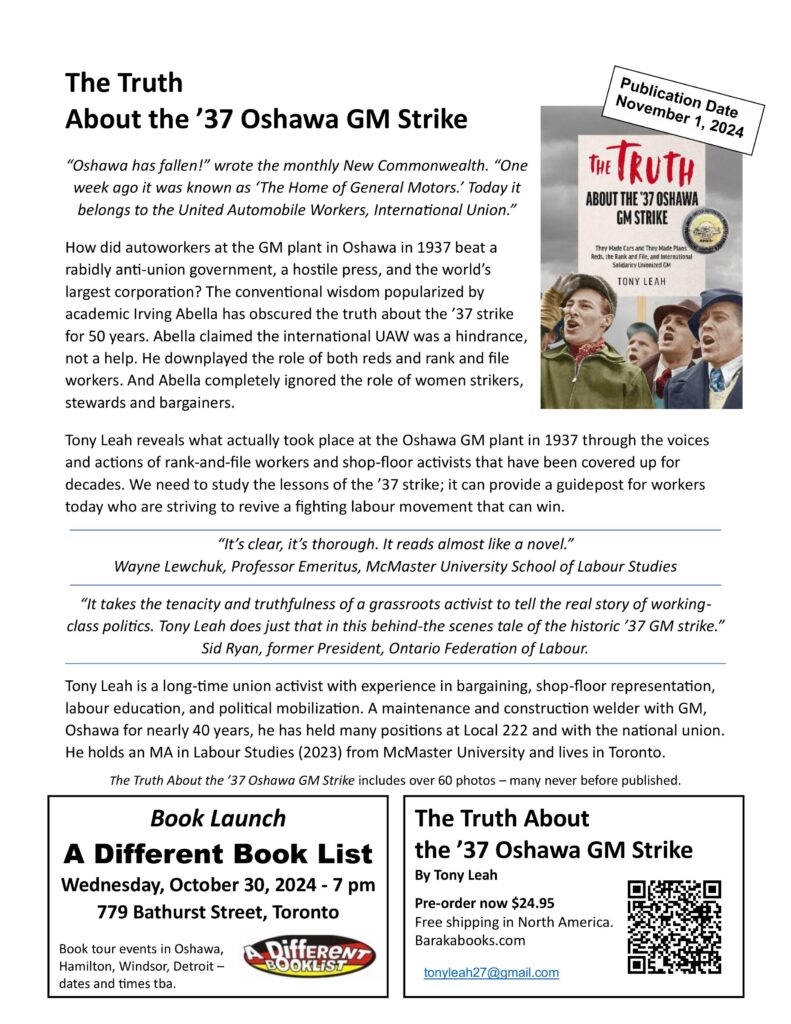
Book Launch – The Truth About the ’37 Oshawa GM Strike
{ Add a Comment }

{ Add a Comment }

Tony Leah, MA Thesis, School of Labour Studies, McMaster University, October 2023.
This MA thesis provides a comprehensive new analysis of the historic Oshawa strike against General Motors in April 1937 that established industrial unionism in Canada.
The Oshawa 1937 strike against General Motors was a major turning point in Canadian labour history. This thesis explores the factors that led to its success, including the historical background of working class struggle; the economic and political context of the times; prior organizing by Communists; the engagement of rank-and-file GM workers and the remarkable stewards’ body they established; and the support and leadership of the UAW International union. The thesis shows there was overlap and interplay between these factors. The influence of the strategic outlook of Communists, both in Oshawa and in the UAW more broadly, meant that the 1937 strike incorporated many features of what might now be called rank-and-file unionism: industrial unionism, democratic engagement of rank-and-file workers, militancy on the shop floor, building solidarity within the workforce and in the community, international solidarity, and rejecting cooperation with corporations.
My research focus was on the voices and actions of rank-and-file workers as much as possible, and on the remarkable day-to-day events of the strike itself. The thesis demonstrates that many of the events and lessons of the strike have been little understood or have been misinterpreted. In particular, I reexamine and correct the long-accepted conclusions of Irving Abella that the Oshawa workers were “on their own” without significant support from the UAW/CIO leadership, and that they (or the Canadian labour movement) would have been better off if they did not organize under the banner of an international union. The thesis also demonstrates that Abella failed to grasp the degree to which rank-and-file principles were embodied by the strike and were crucial to its success. The contending forces of workers, corporations, and rabidly anti-union governments that clashed in Oshawa in 1937 are largely the same ones we see in the battles going on in North America today. Thus, understanding the factors that led to the success of the Oshawa strikers can provide valuable lessons to those seeking to revive today’s labour movement.
{ Add a Comment }
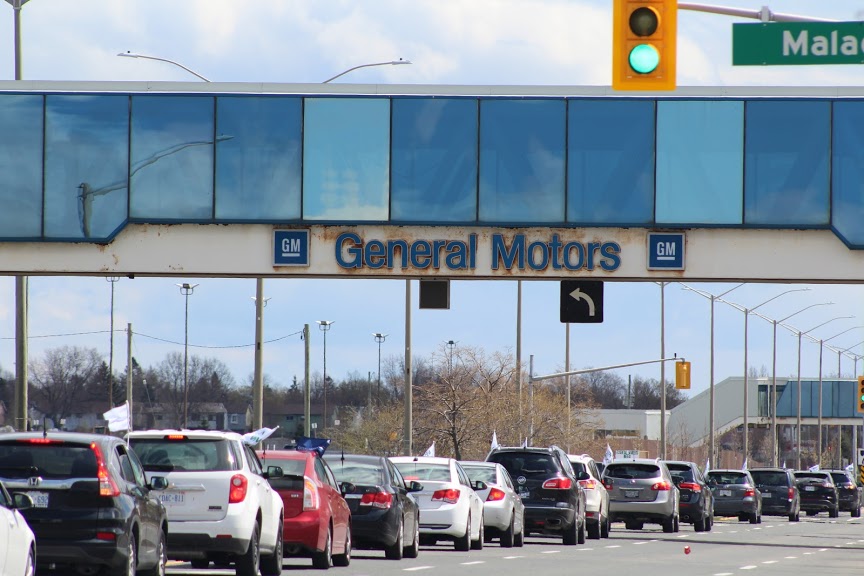
On Saturday, May 9, 2020 a large cavalcade wended its way through the city of Oshawa, past the major city hospital (Lakeridge Health) and Hillsdale Terraces, a long-term care home where Covid-19 has infected 42 residents (of whom 14 died), and 13 staff members. The cavalcade of 65+ vehicles ended up at the sprawling General Motors Assembly Complex, now mostly empty since GM abandoned vehicle production last December.
Support Health Care Workers – Manufacture More PPE
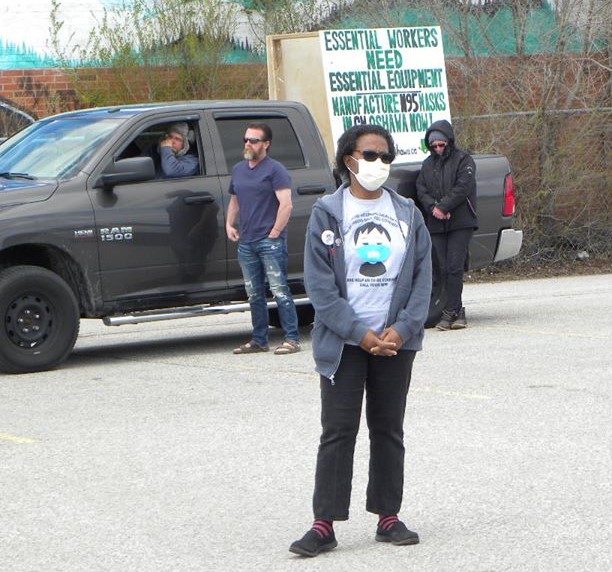
The Cavalcade was organized by Green Jobs Oshawa to demand government action to meet the desperate need for PPE for front line workers by ordering vastly increased production at the GM Oshawa complex, especially of N95 masks. Green Jobs Oshawa led a determined campaign for three weeks that led to a major breakthrough on April 24. On that day the Canadian government announced that GM would manufacture masks in Oshawa. However, GM is only recalling 50 to 60 workers, and will only be making surgical masks, not the critically important N95 masks.
The Cavalcade at Hillsdale Terraces. video by Jesse Michael Cullen
This is the speech delivered by Green Jobs Oshawa representative Tony Leah with the plant behind him, and people standing by their vehicles, or sitting in them and honking, in the employee parking lot.
I want to thank everyone for being here, this is such an important event. This is a great show of support from workers, from the Oshawa community.
We are here to support our front line workers. Those workers don’t need applause; they don’t need medals. What do they need?

They need proper personal protective equipment! They need N95 masks!
And those masks can and must be manufactured here – in the massive, mostly empty GM Assembly Complex behind me.
Let’s review the facts.
There is a shortage of N95 masks:
“Federal government tracking shows that of the 155.4 million N95 masks Ottawa has ordered, 5.3 million have arrived. And a “significant portion” remain in testing, the government’s website says. Globe and Mail, April 30, 2020”. That is a shortage of over 150 million N95 masks.
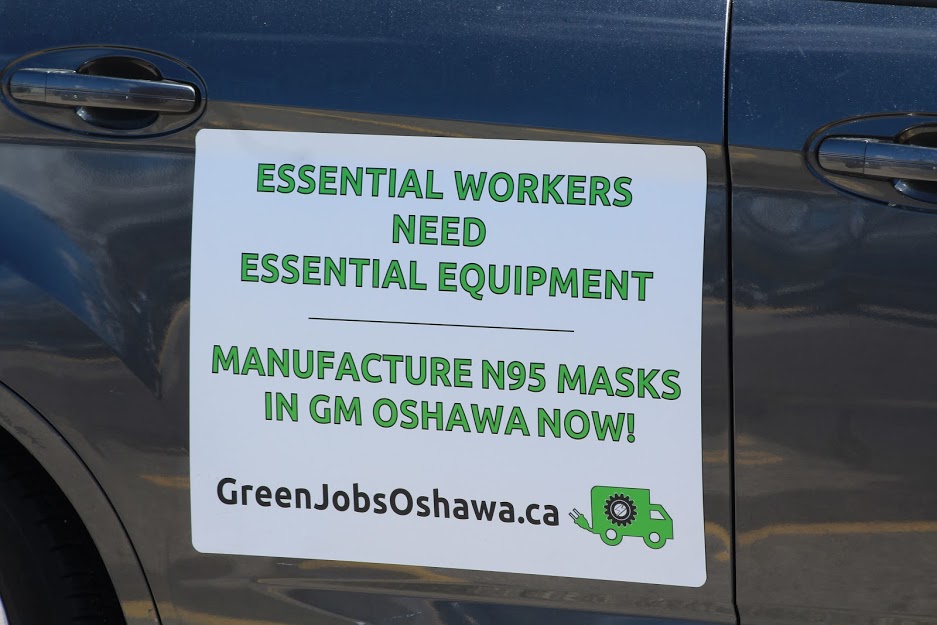
In a recent survey of doctors by the CMA – 71 % said the supply of PPE was worse or unchanged from one month before. CTV News April 28, 2020”
The results of the shortage are devastating.
The Ontario Council of Hospital Unions (OCHU) – CUPE has revealed:
The number of Ontario health care workers infected with COVID-19 rose from 2,016 on April 27 – to 2,892 on May 5. That is an increase of an alarming 43.5% in just 8 days.
Today more than 3,000 Ontario health care workers are infected with COVID-19. Think about that – 3,000 of our front line health care workers have been infected. Five have died.
Those on the health care front lines now account for nearly 16 per cent of the province’s COVID cases. That is an infection rate four times that of China. Our governments are not protecting them.

On April 24 we had the announcement by the Canadian Government that GM will use 50-60 workers to make surgical masks in Oshawa. No N95 masks are to be manufactured. This work is not beginning until May 11.
WHY SO LITTLE? WHY SO LATE?
Timeline:
The Ontario government declared an emergency on March 17 ( the day of the 1st death in Ontario).
The Canadian government issued a “call to action” on March 20 – calling for companies to manufacture needed equipment.
But there have been no orders to corporations, no national planning, no co-ordination. If our governments can mandate workers and remove their collective bargaining rights – they can mandate corporations to meet public needs.
Dismayed by the lack of action, on April 5 Green Jobs Oshawa sent an open letter to Prime Minister Trudeau. It included this sentence:
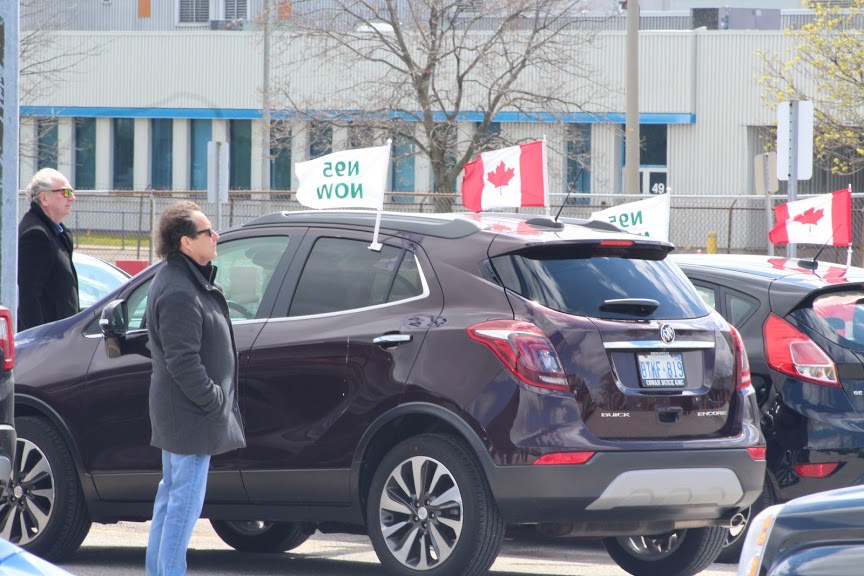
“We are seeing the consequences of not having manufacturing capacity in Canada when the government of the US threatens to prevent delivery of N95 masks manufactured there.”
When the April 24 announcement came – it still did not include N95 masks.
WHY SO LATE?
From March 20 (the “call to action”) to April 24 is 5 weeks.
From April 24 to May 11 is another 2.5 weeks. That is 7.5 weeks just to set up mask manufacturing by 50 workers.
In contrast – China built two complete hospitals, with over 1,000 beds each, from the ground up, in less than 2 weeks. They were completed February 6.
Is our government taking this crisis seriously enough?
WHY SO LITTLE?
GM is manufacturing 3 million masks per month in their Warren, Michigan plant with 140 workers – both surgical masks and N95 masks.
GM’s plans for Oshawa – barely more than 1/3 the number of workers, 1/3 the number of masks – and NO N95 masks!

50-60 workers – when there are 5,000 assembly and supplier workers whose jobs were taken away by GM when they ended vehicle production here.
Mask production will occupy 30,000 square feet out of 10 million square feet (3/10 of 1%).
If GM can manufacture N95 masks in Warren – they can manufacture them in Oshawa! They MUST manufacture them in Oshawa!
We need to take this crisis seriously.
During WWII – the Canadian government ordered industries to convert to necessary war production – including the GM Oshawa plant.
Canada lost 42,000 lives in WWII – about 20 deaths per day for the 2,068 days Canada was at war until VE Day.
Canada has so far had 4,700 deaths from Covid-19 in 61 days – That is 75 deaths per day. For the past two weeks, there have been 150 deaths per day.
Today, the number of Covid-19 deaths in Canada exceeded the death toll in China, a country with 40 times the population.
Are our political leaders taking this crisis seriously enough? They are not doing enough to protect Canadians. They are not doing enough to protect our front line workers.
Support Appreciated
We appreciate the support for this campaign that we have received from the Durham Region Labour Council, the Leap, the Ontario Council of Hospital Unions/CUPE, the Ontario Federation of Labour, Niki Ashton, Jennifer French, the Council of Canadians, Councillor John Neal, who is with us again today, and many others in the community, and across the province and the country.
The Unifor Local 222 Executive Board and the Local 222 Retired Workers’ Chapter Executive passed motions to:
“Endorse the Green Jobs Oshawa cavalcade that is supporting front line health care workers and pressuring GM to produce far more masks, especially the N95 masks, in Oshawa …”
We cannot rest until we have enough PPE being manufactured in this country – for this crisis, and for the next one.
Manufacture N95 masks in Oshawa!
Make essential medical production in Oshawa permanent!
Make it a Crown Corporation to ensure we have a secure supply of critically important products for the future!
{ 1 Comment }

Linda McQuaig spoke recently on The Taylor Report, CIUT 89.5 fm, about her new book, The Sport & Prey of Capitalists. Linda’s book is an intriguing and informative exploration of the history of public ownership in Canada, and demolishes the myth that private ownership is always best.
My book is basically the story of privatization … The doctrine that the private sector always does things better – it’s always asserted by the business community with great confidence, but never with any evidence. In fact, there’s no evidence that they always do things better … overall, the evidence is it’s very costly when we turn to them, when we privatize things and hand things over to them. It ends up costing us a fortune … My favorite example is the 407.
Here is what Linda said about GM’s closure of the Oshawa plant: “Rather than shut down this historic plant that was the centre of the automotive industry in Canada, let’s have government take it over and let’s use it to create green production vehicles … which we desperately need as part of a Green New Deal.”

{ Add a Comment }
Green Jobs Oshawa distributed this leaflet at the Unifor Constitutional Convention on Wednesday, August 21. It calls for government action to establish electric vehicle production in Oshawa, under public ownership.
Links to download PDF copies of the leaflet in English and French are at the end of this post.


A PDF of the leaflet is available for download:
Download the English leaflet
Télécharger le dépliant en français
{ Add a Comment }
Did Jerry Dias make a deal to save the Oshawa plant, or did he give in and accept GM’s determination to end vehicle production in Oshawa?
Just before Christmas last year, GM announced their intention to close Oshawa, meaning the loss of 5,000 direct jobs involved in the assembly of cars and trucks, with a much larger impact on the community of Oshawa – an overall loss of 20,000 jobs.
GM claimed that 2,600 jobs were affected when they announced the closure, and the media has used that figure ever since. But GM knew that they were taking jobs away from 5,000 workers whose jobs are directly part of the assembly of vehicles in Oshawa. It has been GM’s deliberate policy over the years to outsource as much of the work as possible to third-party supplier companies – to force wages and benefits down. Now GM will claim no responsibility for those workers when they leave town. Many of those outsourced jobs are right inside the Oshawa plant – building services trades, cleaners, workers who sequence and deliver parts, security, the tire room. Others are nearby – including workers who make foam and manufacture seats, and other parts suppliers. At one time all of those jobs were done by workers who were employed directly by GM, and had the same wages and benefits as other GM assembly workers. Now they make less than second tier assembly workers, have inferior benefits, and most have no pensions. And almost all of them are members of Unifor – but has Jerry done anything for them?
Unifor President Jerry Dias vowed to fight to keep the plant open. He hired an expensive public relations company, whose strategic brilliance included a “Tree of Hope”, and an ad on the Super Bowl broadcast, rather than relying on workers’ actions. After several months, the “fight” became reduced to talks with GM to maintain a “footprint” and save “as many jobs as possible”.
Finally, on May 8, the deal was announced – only 300 jobs would be saved – That is only 6% of the 5,000 jobs left in Oshawa. And 300 is just 1.5% of the 20,000 jobs that were in Oshawa not too long ago. Those 300 jobs will be reserved for direct employees of GM. Senior GM workers will be offered retirement or severance incentives. Workers hired by GM since 2006 fare worse – they only get credit for time worked since 2016 to qualify for incentive packages. For the 2,500 workers at supplier companies the deal provides zero jobs, zero incentive packages, zero severance beyond the bare minimum provided by law. Yet, they are Unifor members too. They are workers too.
Here are some of my impressions of the deal and how it was announced.

Jerry Dias did not meet with the workers affected by the plant closure to let them know what was in his deal with GM. Instead, he took part in a joint press conference with GM of Canada President Travis Hester on May 8 in downtown Toronto. The backdrop featured the logos of GM and Unifor as though the organizations were partners, and the whole set-up was clearly designed to try to rescue GM’s damaged public image. Jerry was on a first-name basis with Hester, while the workers suffered the indignity of learning about their fate by watching the press conference.
Holding the press conference far away from the workers, who would know how hollow the ‘victory’ was, served a very damaging purpose – it left the public with the false impression that the plant has been saved.
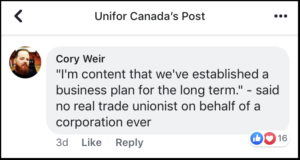
During the Toronto press conference, Jerry praised GM for promising to keep 300 jobs in Oshawa, and said “I’m content that we have established what I believe to be a business plan for the long term”. The workers in Oshawa who are losing their jobs are a lot less content.
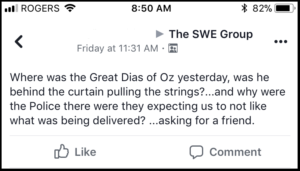
When meetings were held with the members the next day, on May 9, Jerry Dias did not even bother to show up. That is really adding insult to injury. The post on the right shows the reaction of one Oshawa worker.
It wasn’t until the meetings on May 9 that we got more details about the 300 jobs. The jobs will be in the Oshawa Stamping Plant, a small part of the GM complex, and GM’s only commitment is to have the jobs in place by the end of the 2020 calendar year. Our leadership expressed faith “that most of them would start … in the second half of the year”. Since vehicle production will be done in December, 2019, this means that people who apply for the 300 stamping jobs could be on layoff for 6 months or more before they start. I asked at the meeting if there was any guarantee that the jobs would last past the expiry of our contract – September 21, 2020. The short answer was “No”, there are no guarantees, of course. When the contract expires, everything has to be renegotiated. If GM announces next year that they have changed their mind, or that “conditions have changed”, there could be no jobs at all.
The deal that has been reached depends on GM’s good will – which means it is worth nothing. GM has promised 300 jobs – but they have until the end of 2020 to deliver them. And that is after the expiry of Unifor’s collective agreement. Why should we take GM’s word now, when we have already seen what their promises in 2016 were worth? This deal provides very little for the 2,500 GM workers. It provides nothing for the 2,500 workers at supplier companies. Most importantly this deal provides nothing for the community – no jobs for the future, and the loss of important manufacturing capacity for Oshawa, Ontario and Canada. GM is already taking inventory of the equipment they are going to take out and relocate or sell.
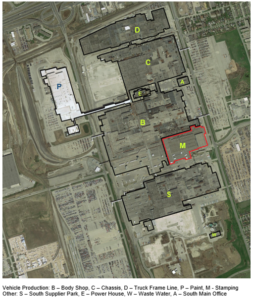
The only realistic way to prevent the dismantling of the Oshawa complex, and the bulldozing of the plant buildings to make space for condos and big box stores, would be for governments to step in and save the manufacturing capacity, and repurpose the plant for electric vehicles, public transit, and renewable energy products. We desperately need that bold action by government anyway to meet the current climate crisis. What better place to start than in Oshawa? If we leave it up to GM, they will put their profits first, and the public interest last. We can’t accept that capitalist cold-hearted logic.
The aerial view shows that GM’s plans will at best keep jobs in a small corner of the Oshawa manufacturing complex – the Stamping Plant outlined in red. All of the automation, robots, technology and equipment used for the assembly of cars and trucks is in the buildings outlined in black – and they will all be empty. We need to force governments to act now, or it will be too late. Can this be done? As veteran union activist Sid Ryan posted recently on Facebook:
One of those alternatives was to push these governments to consider public ownership (nationalise) the Oshawa facility and to repurpose it. After all, the federal and Ontario governments had no problem pumping billions of dollars into GM during the 2008/09 financial disaster brought about by pure greed on Wall St. Why was it ok to hand over taxpayers money to wealthy corporations to enhance their profits in 2008/09 but not do so today to save workers jobs by nationalizing the plant? Furthermore, the federal government had no problem investing in repurposing the Oshawa plants during WWII to churn out military vehicles. Why not now invest in the plant and its workers to design and build electric vehicles, buses and rapid transit systems as just one option?
The Canadian Union of Postal Workers has called for the replacement of the entire Canada Post vehicle fleet with electric vehicles assembled in Canada. That could be the ideal start for a publicly owned manufacturing centre in Oshawa, and the kickstart to a greatly needed Green New Deal.
{ 1 Comment }
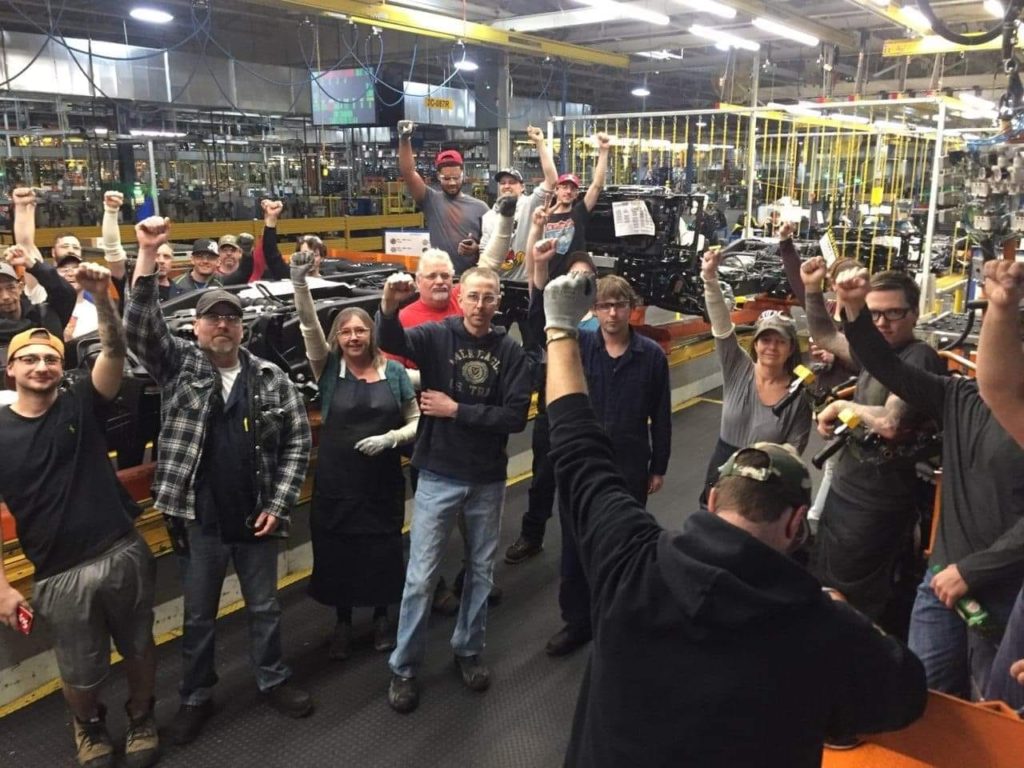
[This interview first appeared in Labor Notes]
General Motors has announced it will end production at five North American plants, just a decade after the company received billions of dollars in U.S. and Canadian taxpayer money and won sweeping concessions from auto unions as part of the bailout.
All told, about 6,700 hourly and salaried employees stand to lose their jobs as the lines stop at Oshawa Assembly in Ontario, Detroit-Hamtramck Assembly in Michigan, and Lordstown Assembly in Ohio. Meanwhile the company is posting billions in profits.
Neither the United Auto Workers nor Unifor, Canada’s largest private sector union, which represents auto workers in Oshawa, has called for job actions, leaving many union activists feeling frustrated and dispirited.
Nonetheless, workers in GM’s Oshawa Assembly Plant took the initiative themselves to shut down production in a sit-down strike this week. Auto workers in Detroit will be protesting GM at the January 18 North American International Auto Show.
Tony Leah is a longtime union activist who has put in 38 years at the Oshawa plant. He chairs the Political Action Committee of Unifor Local 222 and coordinates the union education program in the plant, organizing trainings with members every week on shop floor topics like how to stop harassment and big-picture issues like trade deals.
Labor Notes’ Chris Brooks spoke with Leah on January 10 about the sit-down and why it’s essential that workers use their power on the job—not just a public relations campaign—to bring GM to the negotiating table.
Labor Notes: When did you hear about the company’s decision to end production in Oshawa, and what was the response from your co-workers?
Tony Leah: On Sunday, November 25, in the evening, is when word got out. I believe that the union had received some notification from GM that afternoon, so that started circulating pretty widely.
Monday morning, people were angry. We had been told there would be an announcement from GM, but everyone knew by then that they were planning to close the plant by the end of 2019.
Management told workers we would be gathered together for meetings by 10 a.m. for the announcement, but we all walked out of the plant before that.
The plant was shut down and that evening we had a meeting with the union leadership about what they had heard from GM and what our response was going to be.
What has been Unifor’s response?
There has been a woeful lack of involvement of members in determining strategy and direction. The leadership has not asked members to discuss ideas. It is asking people to show up for small rallies around town waving banners, putting up lawn signs, and so on.
The local union leadership has gone so far as to actively discourage involvement or questions by sabotaging union meetings—for example, directing union reps not to show up, and having them direct members to a banner event instead of the local membership meeting on January 4, resulting in there being no quorum and having the meeting cancelled.
From the national union, while [Unifor President] Jerry Dias has used militant rhetoric, the actual campaign has mainly relied on a public relations company. The campaign is designed to run ads on radio, television, and social media.
They are saying GM is harming workers in the community, which is true—and public support is important. But it’s not sufficient to change GM’s decision. A battle like this requires far more than public sympathy. We have to have a direct impact on their bottom lines and impact their profits. Unfortunately, that has not been a central part of the union’s strategy.
In my opinion, the greatest weaknesses so far are, one, not seeing workers’ ability to stop production as key, and two, ignoring the need for solidarity from the rest of the labor movement in Canada, and solidarity with auto workers in the U.S. and other countries.
Jerry Dias pulled Unifor out of the Canadian Labour Congress a year ago to allow him to pursue raids against other affiliates, which has had a big negative impact on our ability to build a broader fightback. The membership of Local 222 opposed the disaffiliation.
The union is run in a top-down way, so they come up with the strategy and just expect everyone else to implement it. There is no forum for us to discuss how to push our advantage on the production line. The positive actions have been mostly driven by spontaneous actions of the workers.
How were the sit-down actions organized? These were worker-led actions, not initiated by the national union, right?
Everything boiled over this week because we were told that Unifor was meeting with GM in Detroit to discuss keeping Oshawa open. We were told there would be a response from GM that would be announced at a press conference on Tuesday, January 8.
At the time that the press conference was on, around 4:20 p.m. that day, most people were gathered somewhere in the plant to watch it. The announcement was that GM was still going to end production in Oshawa.
So the truck-production shift, which works afternoons, sat down. The whole plant went down as a result, so about 700 people stopped work. People gathered together. Management tried to get people to go back to work. When that failed, management told everyone to leave, and then that failed.
The union had to respond, but the plant leadership was in Windsor at the time and it took them five hours to get to the plant. Eventually the plant chair arrived and gave his speech and led everyone out of the plant. They got no production from that shift.
The action happened because people had built up hope in the union’s meetings with the company and nothing came out of it.
The next day there were sporadic actions, but no overall shutdown or occupation. Lots of people were angry and stopping work and shutting things down in truck and car production. That anger is still there, and the desire to resist is still there.
The national leadership has called for a January 11 rally in Windsor to protest the closing. That’s a head scratcher. We feel like the battle is here.
Can you give me an example of the union’s failed PR strategy?
The best example is the “Tree of Hope.” The union called a press conference in mid-December and said we are going to launch our public campaign against the GM plant closing.
The press conference was in Memorial Park, where the union unveiled this big 20- to 30-foot Christmas tree. They had places where people could leave messages on a banner to show community support. They had Christmas ornaments that say “Save GM Oshawa” that people could order and put on their own trees and then share out on social media.
When you have a campaign designed by a P.R. firm, you get this kind of media stuff and not anything that actually impacts profit generation at the point of production. You don’t get strikes, you get a “Tree of Hope.”
Our members are showing they want to be more aggressive dealing with GM. We showed that on the first day, when we walked out and shut down three shifts. The union told us to go back and show GM what a good job we can do producing for them.
Oftentimes union members don’t want to be too critical of the union, especially when we are under attack. But it is imperative that we question this strategy and push for militant actions.
It seems like the union is totally disconnected from the anger that workers and community members have about GM’s decision, especially given the past history of union concessions and taxpayer bailout.
That’s exactly right. We’ve given up so much over the years. For 10 years, we had 500 people that were classified as “Supplemental Workforce Employees, or SWEs” and were second-tier workers. They performed the same jobs as everyone else, but for far less – first 70%, later 60% of regular pay.
The SWEs were considered to be somewhat like perpetual probationary employees, or contract workers. They did not have a seniority date, which is a fundamental right under any collective agreement. As non-seniority employees they did not have any layoff and recall rights, no pensions, no supplemental unemployment benefits, far fewer health care and other benefits.
GM started using that category of worker in 2007 and got the union to agree to it. Initially, these positions were only supposed to be hired for short periods when there were major plant changes, but GM extended them to all the time.
Finally in 2016 it was negotiated that they were going to be hired as seniority employees. But although some of them had worked for GM since 2007, they were all assigned a seniority date of September 26, 2016. They got no credit for the years they worked as GM employees. That means that if the plant closes this year, they will be considered to only have three years’ service and will not be eligible for any plant closure compensation under the current contract.
These are people doing the exact same job. Our production rate is $35.42 (Canadian) an hour. But second-tier workers are currently making $20.92 to $23.91 an hour. It takes 11 years to reach equal pay. Two people doing the same job right next to each other and one is making $35 an hour and the other makes $21. The union’s justification was that this was what was needed to keep these jobs here, but as we see, it has had no impact on keeping the jobs here. It just added to GM’s profits.
What’s it like working at GM at Oshawa?
It’s changed a lot over the years. When I was first hired, the company was in expansion mode. There were 75 apprentices in my apprenticeship class and 400 total in the plant. In the mid-1980s we had 3,000 skilled-trades and 14,000 production workers in Oshawa.
We’ve gone through a long series of layoffs and the elimination of vehicles we produce. It’s been really difficult. Today, we have about 320 skilled-trades and 1,800 production workers. We have flex lines—car production is on one shift and truck production on two other shifts.
A lot of that workforce reduction is due to elimination of plants and operations, and reduction in vehicle assembly shifts and volume. But a significant part is due to outsourcing of work to third-party companies
Even in our facility, we have eight or 10 other companies that are doing work associated with the plant that used to be GM jobs. Cleaning, building services, sequencing, security, and other operations are now done by workers who work inside the Oshawa plant, but who do not work directly for GM. Even the tire room has been outsourced.
Thus, even though there are only 2,100 GM workers who are represented by Unifor, there are another 1,000 or more who work inside the plant for other employers—most of whom are also members of Unifor Local 222.
That is just within the plant itself. It doesn’t include outside suppliers. All told there are over 5,000 direct jobs that will be lost if this plant closes.
This is all happening at a time when GM’s profits are soaring.
GM’s profits have been incredible since 2010. Just over the last couple of years, GM’s North American profits have been $12 billion (U.S.) annually.
So they are making out like bandits. They took government money, wrote off their debts, implemented two tier systems, and all of that is going to their profits. But there is no commitment to anyone else.
Why are we allowing our entire economy to run on the basis of what is best for corporations and not for our communities? That is the larger question we should be asking, rather than publicly begging GM to keep this one plant here.
If GM walks away from Oshawa, then we should seize the operation and convert production to socially necessary and beneficial work. That’s the kind of issue being raised in Detroit by Autoworkers Caravan and the Detroit Democratic Socialists of America. They’re calling for making Detroit the engine of a Green New Deal.
Those of us that have that outlook are hoping to raise these points at the Detroit auto show on January 18. This action has been endorsed by Local 222’s Political Action Committee and our local’s Retiree Committee. We are chartering a bus to bring workers to that action in Detroit.
Unifor has also followed the UAW in making explicitly nationalistic appeals to these companies, pushing for what is best for Americans or Canadians, as opposed to what is best for workers.
Fundamentally, our issues as workers are common. All workers that are dealing with GM should have solidarity with one another.
I don’t see that coming from our national union’s leadership, unfortunately. They frame everything as GM betraying Canada and we need to save Canada. They aren’t trying to build common efforts for workers in the United States or to build international solidarity with workers in Mexico.
Our national union has ties to the Liberal Party of Canada, which involved Jerry Dias as part of its NAFTA renegotiation team.
This isn’t your first plant occupation. Can you talk about what happened in 1996 and how that informs what you think would be an effective strategy today?
That was the year we went on strike. GM tried to take dies [specialized tools used to cut and shape particular parts] out of our plant while we were on strike so they could maintain production.
There were parts that were produced in Oshawa that were needed for plants in the United States. Due to the strike, production in the States would shut down. So GM tried to get an injunction and seize these dies to maintain production and break the strike. In response, we occupied the plant.
We learned that we shouldn’t concern ourselves with legalities, but with what is an effective strategy given the circumstances. The history of our union is that we have to occupy plants to make gains, whether that occupation is legal or illegal.
In our current situation, we have more bargaining leverage with GM while they have production scheduled for our plant. Currently we are making old-model pickup trucks while the Fort Wayne Assembly Plant is being retooled for the new model. GM wants to maintain market share in the meantime. So truck production continues here.
GM makes huge profits on these trucks—estimates are $15,000 per truck. The trucks we are scheduled to build here before they shut the plant will generate $1 billion in profit for GM.
That gives us bargaining leverage and power over this corporation. They don’t care about a Tree of Hope. They want these trucks and this profit.
We shouldn’t hand it over to them. If they want those trucks, then they have to give us something in return. We have to use our power on the job, which is far more important than ads on television. And it needs to happen before they get all the production they want.
Under current circumstances, sitting down on the job is more powerful than walkouts and even traditional strikes.
Once we’ve taken the plant over, we can begin to lead a national conversation about who is going to run it in the future. It would be powerful to involve the community and government in a discussion about what we can do with this production capacity once it is put in our hands for our benefit, rather than GM’s.
This interview first appeared in Labor Notes, January 11, 2019.
{ Add a Comment }